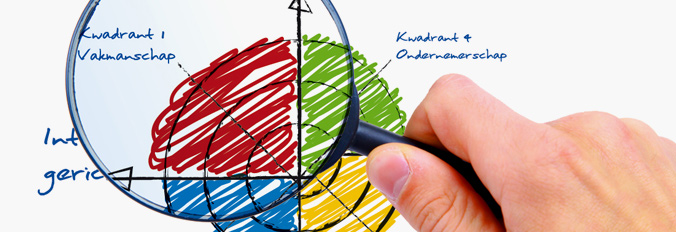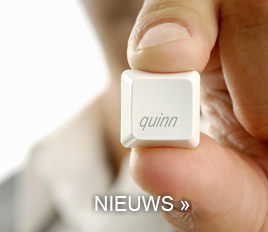Links with various other models
Models also continue to develop. A new model that causes organisations to change arrives every couple of years. The approach in question rapidly becomes all the rage, and books about the models become bestsellers. The hype usually passes after a couple of years, after which another model enters the same short lifecycle.
At the Quinn Association we link different models to Robert Quinn's competing values framework. By creating such links it becomes possible to link the strengths and insights of model A to the strengths and insights of model B.
Simple terms
Let us give you an initial example using some simple terms.
Essence
An organisation can adopt various points of focus in its approach:
- A focus on professional skills;
- A focus on the process;
- A focus on the market;
- A focus on entrepreneurship
Link with Quinn
These four words then fit into the Quinn model as follows:

For example, we have also placed all sorts of comments in the four Quinn quadrants. A selection is given below:
Quadrant 1:
- If you're honest with yourself, you can never lie.
- Many butterflies deny that they were once a caterpillar.
- He's like an open book … that I have no wish to read.
- Thinking is essential if you are going to say what you think.
- Doing is easy, persisting makes the difference.
- Everyone is themselves - who else would you be?
- The truth is always with the person you trust.
- Follow the leader is an order; but you have the choice.
- You can't shake hands if you make a fist.
- Talking to people who agree with you is like communicating with an echo.
Quadrant 2:
- Follow your values, and everything you do will be valuable.
- Routine: deciding every day to do something you've never done before.
- Those who cook are always ahead of those who eat.
- Those who cannot remember the past are doomed to repeat it.
- If everything is under control, you're not moving fast enough.
- The length of a progress report is in inverse proportion to the progress.
- Quality means ruling out coincidence.
- Give me a job that suits me, and I will never need to work again.
- Planning results in haste.
- A couple of steps back can be the start of a run-up.
Quadrant 3:
- A meaningful vision makes the collective heart beat.
- The greatest power that a person has is the power to choose.
- Never think that you cannot win.
- Time is valuable, the time in your life is priceless.
- No journey is too long if you're in good company.
- It's not enough to aim - you have to hit the target.
- Never underestimate the strength of telling a good story.
- Never buy things with a handle - it means work.
- Turn your face to the sun and the shadows will fall behind you.
- There's no such thing as bad weather, just inappropriate clothing.
Quadrant 4:
- Those who have no dreams, have no reality.
- The secret of success is to be able to see yourself through the eyes of others.
- The fact that you're standing in a lift does not mean you're going up.
- You need to wake up in order to make dreams a reality.
- Some things need to be believed in order to be able to see them.
- A person with no story should travel.
- It's better to get lost than remain stuck in old patterns.
- Freedom is knowing who you are.
- An eagle sees more than an ant.
- Wise people don't point.
We have linked the following models to the Quinn model:
- Four Phase model for increasing organisational capacity by T.W. Hardjono
- Colour Print Thinking by L. Caluwé
- Deming Circle
- INK development phases
- Different organisational structures
- Treacy & Wiersema
- Belbin team roles
- Edward de Bono's Hats
- New Working
- Adizes management roles
- CANVAS business model
- Lift mindsets by Robert Quinn
- Click here to pose your question
- Previous page





